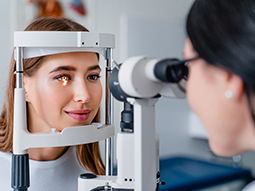What is dry eye?
Dry eye (also called keratoconjunctivitis sicca, KCS, or dry eye syndrome) is a condition in which a person’s eye is not sufficiently lubricated. Dry eye can be caused by poor quality tears or low tear production.
Healthy tears include water, mucus, oils, and antibodies. Patients with dry eye may have a typical supply of tears, but experience dry eye because these tears are of poor quality. Poor quality tears do not have the needed makeup to sufficiently and consistently coat the eye with moisture. Other dry eye patients may have a low supply of otherwise healthy, quality tears.
Tears are an important cleaning and defense system for the eyes. Healthy tear production keeps the eye moist, washes away debris that could scratch the eye, and reduces infection risk. Dry eye interferes with these functions. At MedStar Georgetown University Hospital, our experienced ophthalmology team can help dry eye sufferers to feel comfortable again.
What are the symptoms?
Dry eye can cause significant discomfort. Common dry eye symptoms include:
- A burning or scratching sensation in one or both eyes
- Feeling like something is in your eye
- Blurred vision
- Sensitivity to light
- Red eyes
- Strings of mucus in your eyes
- Discomfort when wearing contact lenses
How is it diagnosed?
Diagnostic tests for dry eye are completed in an outpatient setting. A member of your MedStar Georgetown ophthalmology care team will first talk with you about your symptoms and medical history. He or she will want to know about the issues you are experiencing with your eyes, as well as any medications you may be taking or medical conditions you may have. You may be asked to complete standardized questionnaires that will give your physician more information about the severity and frequency of your symptoms.
Next, your ophthalmologist will conduct an eye exam. During the exam, he or she will look at the structure and function of your eye and examine the quantity and quality of tears produced. This may involve dispensing dyed eyedrops that will allow your ophthalmologist to observe how well tears spread throughout your eye and how quickly your tears evaporate. He or she may also collect a sample of your tears for analysis.
How is it treated?
At MedStar Georgetown, our ophthalmology team will work with you to find the most effective treatment for your dry eye symptoms. Treatments for dry eye include:
- Eye drops (artificial tears) that supplement natural tear supply
- Eye drops that increase natural tear production
- Eye drops or medications to address inflammation, redness, or infection
- Blocking tear ducts with removable plugs, so that natural tears do not drain from the eye as quickly
Our providers

Expert opthalmology care
Getting the care you need starts with seeing one of our ophthalmologists.









